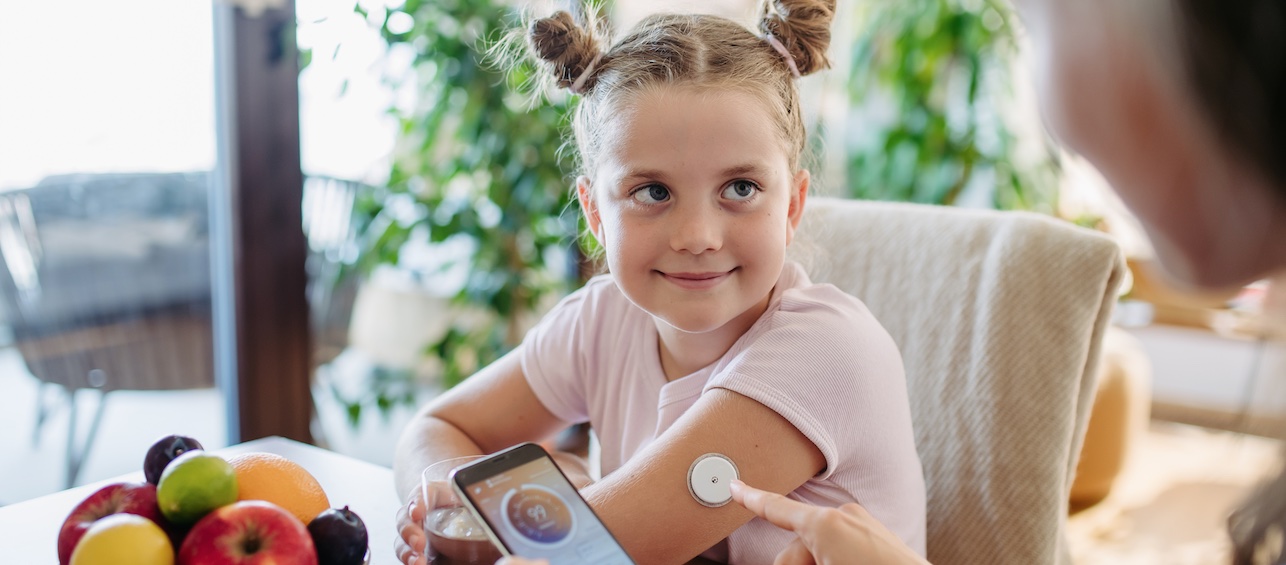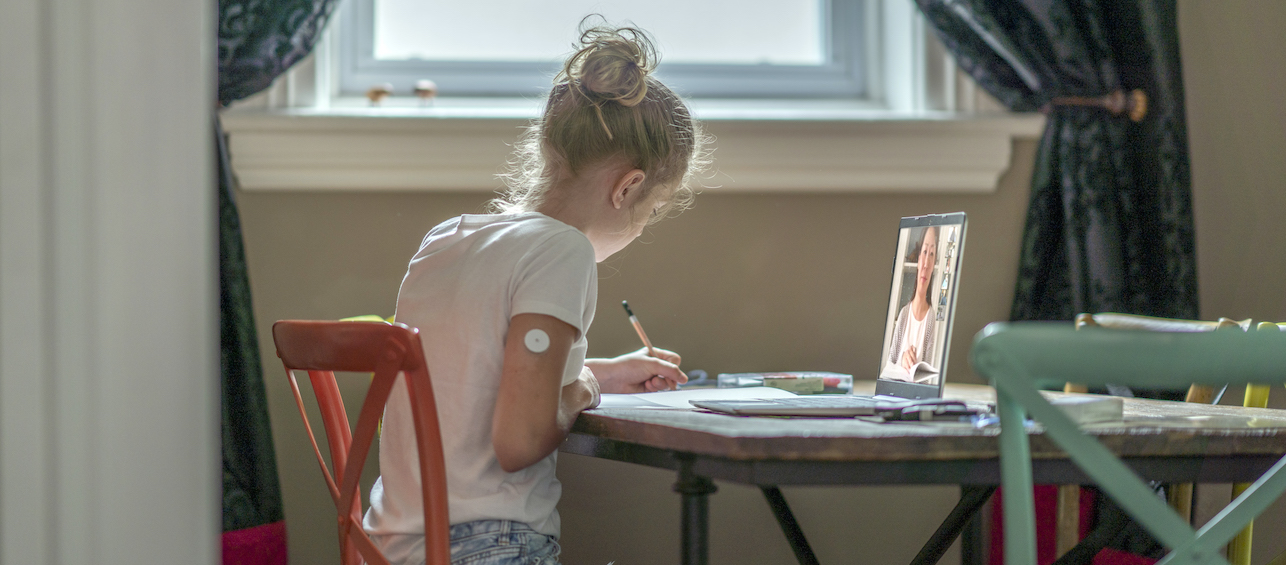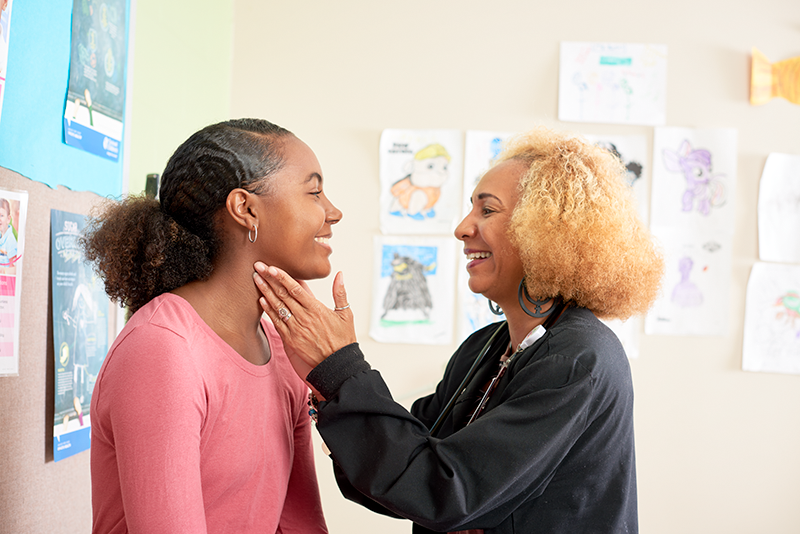For kids with diabetes, advances in technology go well beyond accessing the latest online game or social app. These advances mean better healthcare: longer-lasting insulin, more accuracy in measuring blood sugar levels, fewer finger pricks and insulin injections.
I was diagnosed with Type 1 diabetes (T1D) in 1990 when I was a child. Now I’m a pediatric endocrinologist helping to care for others who have diabetes. Years ago I didn’t think there would be a time in my life when someone with diabetes wouldn’t need to do a finger prick to test their blood glucose level. But that’s happening now and a whole lot more!
Here’s a now-and-then look at how advances in technology are changing lives for children with diabetes and their families:
How we take blood glucose readings
NOW: Advances in glucose meters mean you can get a precise blood sugar reading in 5 seconds today. And these meters require much less blood than in the past. They also can communicate with an insulin pump or a cell phone. Plus, continuous glucose monitors make it possible to receive blood sugar readings every 5 minutes without the need for finger pricks.
THEN: In the early 1990’s, we tested blood glucose levels by placing a large drop of blood onto a test strip (lots of fingertip squeezing going on here). You had to wait a whole minute, wipe it off, then another whole minute to read it. We then compared what the strip looked like to a picture to see what range our blood glucose level was in (for example, 80-120). Glucose meters, or glucometers, came out soon after that. These would give a single number instead of a range — definitely more accurate — but we had to wait a full minute for a reading rather than the quick 5 seconds of today.
When we can take insulin
NOW: Insulin is now made synthetically in a lab. Changes in how insulin is made mean that it can be shorter acting. Instead of having to take insulin 30 minutes prior to eating, it’s possible to take some types of insulin right before eating or even 10 minutes into eating. Now, people dose their insulin based on the exact amount of carbs they are eating, which means a lot more flexibility in when and what they eat.
THEN: Insulin used to come from cows and pigs (bovine and pork insulin), and there used to be only two types of insulin: Regular and NPH. People with diabetes would get insulin injections at set times twice a day and would have to follow a very strict eating schedule — regardless of whether they were hungry, and regardless of whether it was convenient to eat at that time. It used to take quite a bit of time to take effect in the body, so you would have to take your injection 30 minutes before eating breakfast and dinner.
How we get our insulin
NOW: Today’s palm-size insulin pumps do a lot of work for us that we used to do on our own. Instead of insulin injections multiple times each day, these pumps supply a steady flow of insulin into the body 24 hours a day. And they can calculate how much insulin is needed for meals. Two pumps available connect to a continuous glucose monitor, and the pump program adjusts the insulin continually to keep your blood sugar as close to your target range as possible. Now we see patients who almost always wake up in their target blood glucose range and don’t have lows overnight.
THEN: The first insulin pumps, from the early 60’s, were the size of a large backpack. They got smaller over the years, but the user still had to do all the work. You would tell the pump when your blood sugar was high, and you would have to suspend your pump if your blood sugar was dropping too low. You would be the one figuring out how much insulin to give yourself depending on all the variables.
How glucagon is administered
NOW: Severely low blood sugar can be extremely dangerous. It’s crucial to act fast in these situations by giving glucagon. But until recently, there was only one way to do this. In the summer of 2019, the first nasal glucagon was released. This can be squirted into the nose — simple, easy and effective. Another new option, a syringe prefilled with glucagon, also became available recently.
THEN: For the last 50 years, the only glucagon available came in a kit, with a fluid-filled syringe and a vial of glucagon powder. To administer this, the user must empty the syringe into the vial, mix the powder, refill the syringe, and then give the injection — quickly and under a great deal of stress.
How we keep records
NOW: Smart phones to the rescue! Diabetes brings with it a lot to keep track of: blood glucose levels, carbs, basal rates, bolus doses and more. Fortunately, technology is helping make a lot of that easier. Here are just a few of the things those with diabetes can use an app for these days:
- Receive continuous updates from your glucose monitor, and link with phones of parents or other caregivers, such as a school nurse
- Calculate insulin amounts
- Track food and exercise
- Monitor blood sugar levels and see trends
- Receive treatment recommendations — some apps have alarms you can set to remind you to take meal time or basal insulin
THEN: Prior to all this technology, people with diabetes used pencil and paper, recording notes in a log book they carried everywhere they went.
You can see from these differences that we’ve come a long way in helping those with T1D manage their disease. I’m excited about the advances that have been made in this field. Because diabetes is so challenging to manage, as a patient and a doctor, I am grateful for the technology that makes things a little easier for both my patients and me.
If you or your child has T1D and would like to use more technologies, I encourage you to talk to your endocrinologist. There are many factors in insurance coverage for these technologies and overall affordability for families. It can be complicated, but we are committed to working with families to incorporate technology in T1D care.







I am a mother of two diabetic teens, I am struggling with our current Pediatric Endocrine Doctor who is not on board with putting our kids on a pump without certain critera needing to be met prior to this.. it’s very frusterating and the one child who needs this pump the most has been denied.. I was able to order an Omni Pod pump for one child and it’s sitting in a closet not being used until this child lowers her b.s to around 110.. unacceptable and not realtisic.. what advice can you give me.
Thank you
A concerened parent/caregiver